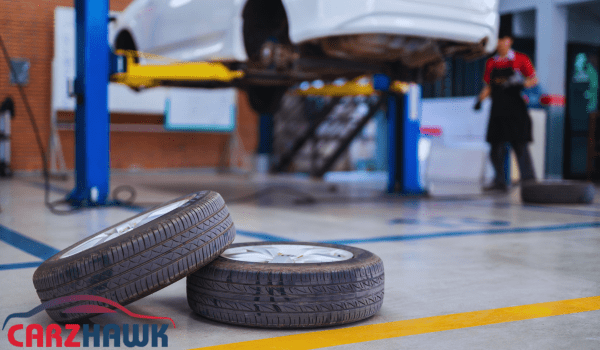Since a car’s screen shows a “tire pressure sensor fault” message, it can be annoying and possibly dangerous. Now that we know what’s happening, you can determine what it means for you and your car.
These days, new cars have a system that automatically checks the air pressure in the tires. This safety feature can inform the driver ahead of time if there is a slow leak, which can help keep the car from breaking down or even causing an accident.
What Does the TPMS Light Mean?
In this case, tire pressure sensor fault means a problem with the vehicle’s Tire Pressure Monitoring System (TPMS). Sometimes, the light will come on to let you know that the tire’s air pressure is too high or too low. Occasionally, it means something is wrong with the system.
Make sure you know the difference by reading your owner’s guidebook.
Where to Find the Tire Pressure Sensor
There is a tire pressure sensor inside every tire. It is generally attached to the valve stem, where you add air to the tire. There is one inside each tire, so anyone could be the problem that makes the monitor show a fault or warning.
Reasons Why the Tire Pressure Sensor Fault Blinks
Several things could cause the tire pressure sensor warning light to blink.
1) The tire level is too low
If your car’s TPMS light blinks, it could mean that at least one tire is low. Some vehicles have a button that lets you check the pressure inside the car. This way, you can press one button and see the pressure for all four tires.
In some cars, they’ll only say that the pressure isn’t proper. Then, you need to check each one with a tire gauge. Ensure all of them are fully inflate according to the manufacturer’s instructions.
2) Tire Pressure Sensor Didn’t Work
Sensors that check tire pressure have batteries that can die. They last a long time most of the time, but if they run out of power, the monitor will show a warning. Sometimes, the sensors stop working because they are worn out or rusted, which also sends an alert.
In either case, if the monitor stops working, it must be replaced.
3) Sensor Could Not Connect
There are sensors in the TPMS system that send data to the computer in the car. The system will inform them about a dashboard problem if their link loses. You might hit a hard bump or something else that could make that happen.
4) New tires or wheels
You should reset the system if you just put new tires on your old wheels or got new wheels for your car. Because if you change how the wheels and tires are set up, you must connect either new or old sensors to the system again. It’s also possible that the car will need a different pressure than the one you set because of the changes you made.
For example, if you switched from winter to summer wheels, you might need to change how much power the system needs.
5) Weather and temperature changes
Many people have tire pressure sensor fault when the temperature changes quickly and drastically. That’s because the air temperature changes how much pressure is in your tires. There will be less pressure when it’s very cold. The pressure will also rise as it warms up.
Why you should pay attention to the tire pressure sensor warning
If you ignore the tire pressure sensor warning, a small problem will get worse. Tire pressure sensor fault are generally small and easy to fix, but you should pay attention to them. The TPMS system has only one goal to keep you safe.
If your tires lack air pressure, you could lose control of your car while driving. You could also get a flat tire if you don’t fix it immediately when your tire pressure drops. A slow leak could leave you stuck. Not putting the right amount of pressure on your tires can also hurt your gas usage, making you less fuel-efficient.
How to Fix a Broken Tire Pressure Sensor
Often, it’s straightforward to fix a tire pressure sensor mistake. You only need a few tools to check the pressure in each tire by hand.
What Tools and Equipment You Need
You’ll need a compressor and an air gauge to fix a problem with your tire pressure.
Allow the Tires to Cool Down
The tires need to be cold before you check the pressure. If you go for a drive, leave the car alone for a few hours or the whole night.
Take off the valve stem cap.
Pick a tire on the corner of the car to work on first. Please take off the cap on the valve stem to get to it.
Check the Pressure of the Air
Press your air gauge against the valve’s stem to read the pressure. Compare that to what the maker says should be done to set up your car.
Decide on the Right Pressure
Connect the air compressor’s line to the valve stem and pump up the tire to change the air pressure. However, exercise caution so as not to explode.
If you do, you’ll have to press the release button on the back of the gauge to let some air out.
Start the TPMS up again
You can set the TPMS again now that you know the proper pressure. Every car is unique. But most of the time, that means starting the car and going a short distance. Following the on-screen instructions, you can then set up the machine again.
Following this process, you can also change the air pressure to what you want. For example, most cars need more air in the tires if you plan to drive with more stuff than average. Let the TPMS know something has changed. If not, the light might stay on.
How to Repair a Tire Pressure Sensor Fault
If the sensor has only lost its link, you can get it to work again by setting up the system again. Just do what the screen tells you to do and what the owner’s manual says. If the sensor is broken, it will need to be replaced. Someone must take the rim and tire apart, so you must bring your car to the shop.
How to Figure Out Which TPMS Sensor Is Broken
Some cars will show you on the panel if a sensor is broken. Sometimes, cars will only tell you something needs to be fixed; you must figure out which TPMS monitor is broken. Most of the time, you can use a code reader to connect to the computer and figure out what’s wrong.
You could also swap out each wheel on the car for a different one until you find the one that’s giving you trouble if you have extra wheels and tires.







